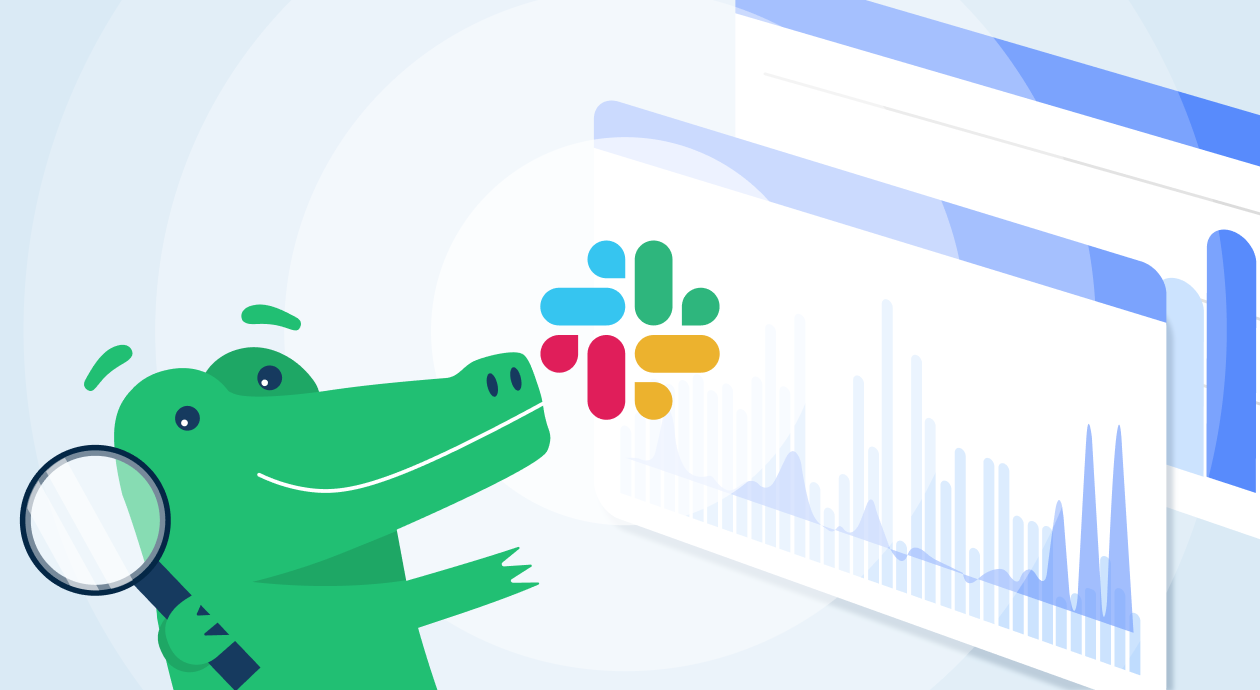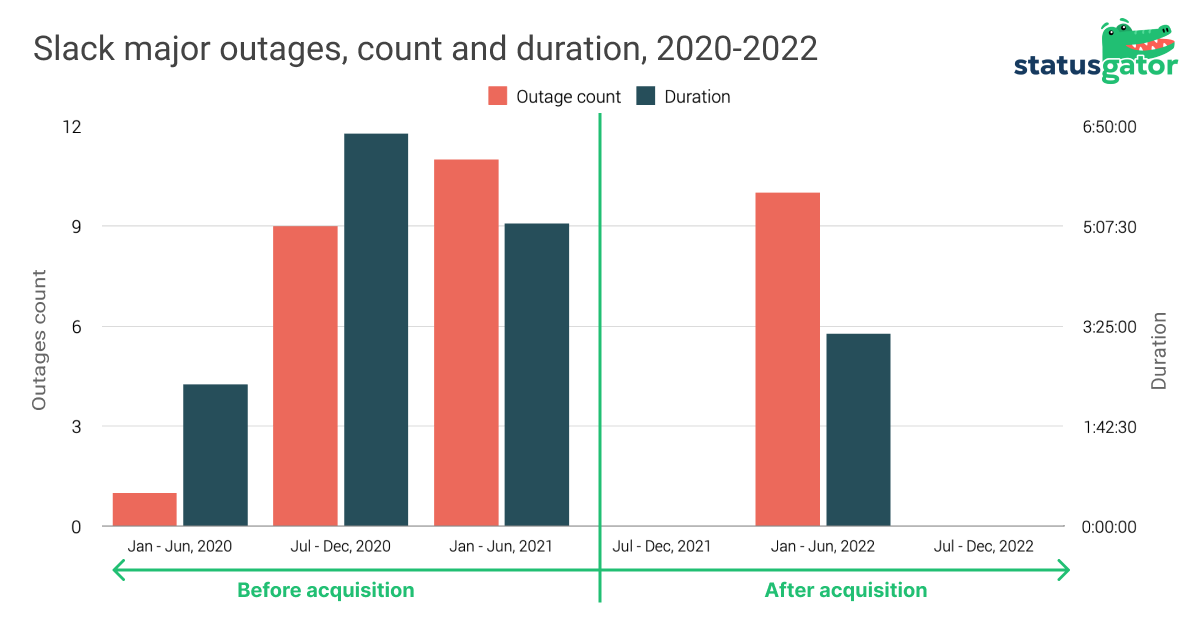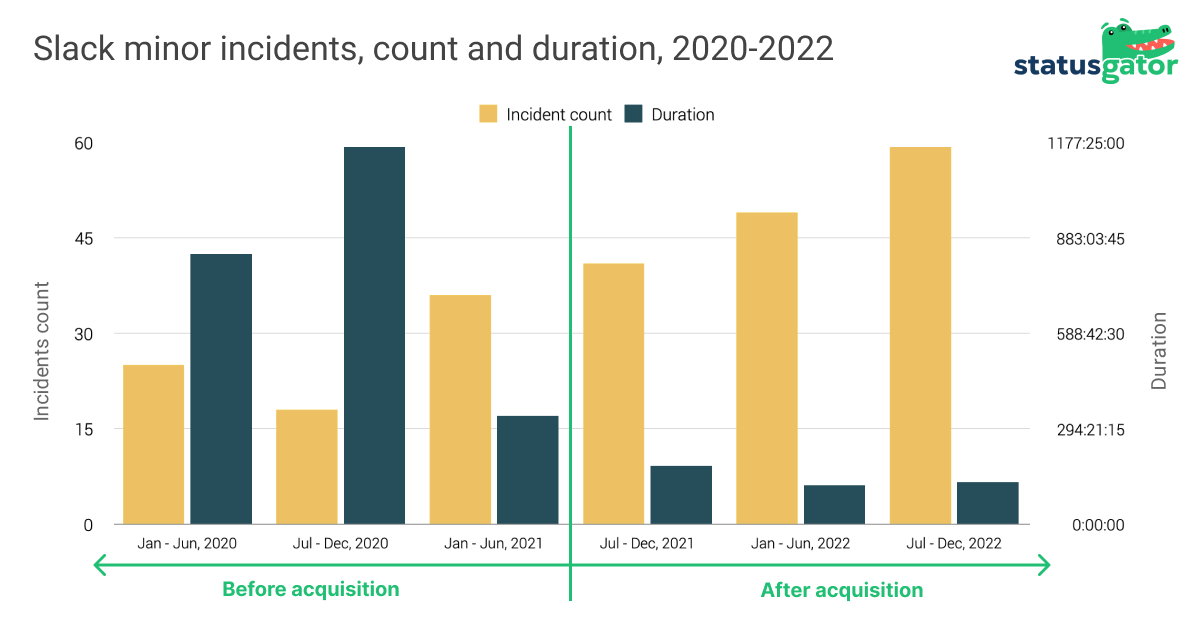
Slack is a popular messaging and communication platform used for work, study, groups, and communities. According to Techjury, more than 10 million people used Slack every day in 2022, and 43% of Fortune 100 businesses are paying for Slack subscriptions.
On July 21, 2021, Salesforce completed its purchase of Slack for $27.7 billion and announced plans to make Slack an operating unit under Salesforce.
In February of 2022, roughly 6 months after its acquisition, Slack exhibited one of its biggest outages ever recorded, lasting 3+ hours followed by more than 10 hours of minor incident status.
Looking at this major outage, we questioned if Slack is more or less reliable after the acquisition by Salesforce, similar to our previous overview of GitHub downtime after its acquisition by Microsoft.
To evaluate this, we reviewed Slack’s reliability over time.
The Data Behind This Article
To collect data for analysis, we used our own product, StatusGator. StatusGator aggregates data from status pages and presents it clearly, generating a unique dataset that allows us to analyze Slack’s reliability effectively.
Slack’s status updates use two terms to indicate downtime severity: incidents (marked yellow) and outages (marked red). StatusGator, on the other hand, uses “warn” and “down” respectively to rate the severity of downtime.
For clarity, we used Slack’s terms but enhanced them, so in this article, “minor incident” refers to an incident (which Slack shows in yellow), and “major outage” refers to an outage (which Slack displays as red).
We analyzed minor incidents and major outages over a period starting January 1, 2020, until December 14, 2022. To analyze the effect of acquisition, we compared major outages and minor incidents before and after the acquisition as follows:
- A general overview
- Monthly status changes and duration
- Reliability of each Slack feature
Slack’s Reliability Before and After Acquisition
We calculated the total number of outages recorded before and after the acquisition. Then we divided this number by the total number of months for that period to calculate an average value for the major outage count.
Analysis of Major Slack Outages Before and After July 2021
We analyzed monthly major outages of Slack and compared average values before and after the acquisition.
| Before acquisition | After acquisition | Change | |
|---|---|---|---|
| Outage count | 1.1 | 0.6 | ⬇-0.5 (~45%) |
| Outage duration | 2:51:00 | 1:55:53 | ⬇-0:55:07 (~30%) |
From this table, we can see that Slack’s reliability improved after the acquisition. The average number of outages decreased by 45% and the average outage duration was 30% shorter.

Analysis of Slack Minor Incidents Before and After July 2021
We analyzed monthly minor incidents of Slack and compared average values before and after the acquisition.
| Before acquisition | After acquisition | Change | |
|---|---|---|---|
| Incidents count | 12.74 | 14.29 | ⬆+0.89 (~7%) |
| Incidents duration | 123:17:41 | 85:03:58 | ⬇-38:13:47 (~31%) |
On average, the minor incident frequency slightly increased after acquisition by 7%. However, the average incident duration dropped by 31%, which we consider a significant change.
Slack’s Reliability Before and After the Acquisition

From this chart, we can see that post-acquisition, there was one outage recorded affecting all 10 features of Slack. Pre-acquisition, however, there were visibly more major outages.

We can see from the chart that the minor incident number appears higher post-acquisition. Incident duration though went down.
So far, it seems major outage frequency and duration are lower post-acquisition, but the number of minor incidents increased. To go further, we must look at individual features.
Slack’s Reliability by Features
The chart below represents the total outage number and duration for each feature before and after the acquisition.
| Feature | Major outage count | Major outage duration | ||||
|---|---|---|---|---|---|---|
| Before | After | Change | Before | After | Change | |
| Apps/Integrations/APIs | 2 | 1 | -1 | 4:01:00 | 3:17:00 | -0:44:00 |
| Calls | 1 | 1 | 0 | 3:50:00 | 3:17:00 | -0:33:00 |
| Connections | 5 | 1 | -4 | 13:11:00 | 3:17:00 | -9:54:00 |
| Link Previews | 2 | 1 | -1 | 4:01:00 | 3:17:00 | -0:44:00 |
| Login/SSO | 2 | 1 | -1 | 4:01:00 | 3:17:00 | -0:44:00 |
| Messaging | 3 | 1 | -2 | 9:26:00 | 3:17:00 | -6:09:00 |
| Notifications | 1 | 1 | 0 | 3:50:00 | 3:17:00 | -0:33:00 |
| Posts/Files | 2 | 1 | -1 | 4:01:00 | 3:17:00 | -0:44:00 |
| Search | 2 | 1 | -1 | 4:01:00 | 3:17:00 | -0:44:00 |
| Workspace/Org Administration | 1 | 1 | 0 | 3:50:00 | 3:17:00 | -0:33:00 |
What can we conclude from this feature data? First, there is no increase in outages for any feature. We can also see:
- Significant improvement for the Connections feature, as the outage number and duration are much lower post-acquisition
- Minor improvement for 6 features out of 10
- No improvement in the outage number for Slack Calls, Notifications, or Workspace/Org Administration
- Improvement in outage duration for all features, with significant improvements in Messaging and Connections.
Before the acquisition, there were major outages for 1-2 individual features. After the acquisition, no outages for stand-alone features were observed.
Overall, Slack exhibited more major outages in 2020 than in 2021 and 2022.
As for minor incidents, the chart below represents the total incident number and duration for each feature before and after the acquisition.
| Feature | Minor incident count | Minor incident duration | ||||
|---|---|---|---|---|---|---|
| Before | After | Change | Before | After | Change | |
| Apps/Integrations/APIs | 46 | 31 | -15 | 1230:19:00 | 108:27:00 | -1121:52:00 |
| Calls | 11 | 8 | -3 | 24:32:00 | 166:17:00 | +141:45:00 |
| Connections | 44 | 50 | +6 | 152:36:00 | 239:03:00 | +86:27:00 |
| Link Previews | 7 | 4 | -3 | 4:01:00 | 3:17:00 | -0:44:00 |
| Login/SSO | 20 | 59 | +39 | 4:01:00 | 3:17:00 | -0:44:00 |
| Messaging | 43 | 59 | +16 | 9:26:00 | 3:17:00 | -6:09:00 |
| Notifications | 20 | 9 | -11 | 3:50:00 | 3:17:00 | -0:33:00 |
| Posts/Files | 10 | 25 | +15 | 4:01:00 | 3:17:00 | -0:44:00 |
| Search | 20 | 12 | -8 | 4:01:00 | 3:17:00 | -0:44:00 |
| Workspace/Org Administration | 22 | 12 | -10 | 3:50:00 | 3:17:00 | -0:33:00 |
There is a wide distribution across all the features, with both significant improvements and declines observed. We can also conclude:
- 6 out of 10 features show a decrease in minor incident numbers after the acquisition.
- A noticeable increase in minor incidents was seen for the Connections, Login/SSO, Messaging, and Posts/Files features.
- Incident number and duration do not always correlate. For example, Calls experienced fewer incidents after the acquisition, but the total duration of incidents increased by 141 hours and 45 minutes.
- The Login/SSO feature saw the largest increase in the number of minor incidents: +39 incidents (295% increase).
- Changes in minor incident duration fluctuate massively across the features, with most features showing significant increases or decreases.
For minor incident history, there are two notable features that experienced significant changes:
- The Apps/Integrations/APIs feature saw a decrease in duration of nearly 1,122 hours (91% decrease), which is equivalent to 46 days.
- Posts/Files saw the largest increase in the duration of 166 hours and 42 minutes (695% increase), which is nearly 7 days.

Summary
Major outage numbers and duration have decreased overall since Slack’s acquisition by Salesforce. We see this as a positive change.
The number of minor incidents after the acquisition has increased, both overall and for individual features. However, we interpret this as a positive development – even minor issues that might impact users are being posted to the Slack status page, which demonstrates better transparency from Slack. Posting an incident and resolving it efficiently is far more effective than not posting it at all.
If Slack maintains this transparency, which we highly encourage, its users will benefit from it. We assume that in the past, Slack only indicated longer-lasting minor incident statuses, whereas now users are kept up-to-date on all minor incidents.
Based on our analysis, we can safely say that Slack’s reliability has increased since being acquired by Salesforce.
Monitor Slack’s status and the statuses of your other vendors with StatusGator.
For readers interested in exploring additional tools that work with Slack, Wrenly AI is worth considering. It offers unique features that can further enhance team communication and collaboration.
FAQ on Slack performance after the acquisition by Salesforce
Q: What caused the Slack outage?
A: Typically, Slack does not provide much detail on what caused the Slack outage. Whenever an outage occurs, Slack status changes to either “ongoing investigation” or “resolved,” with minimal additional details provided. If you wish to receive alerts for changes in Slack’s status, consider signing up for StatusGator to monitor Slack and the statuses of various cloud services.
Q: Is the Salesforce acquisition of Slack complete?
A: Yes, the acquisition of Slack by Salesforce was successfully finalized on July 21, 2021. To examine how Slack’s reliability has evolved since the acquisition, you can refer to the report prepared by StatusGator.
Q: Did Slack’s reliability improve after the acquisition by Salesforce?
A: Indeed, since joining forces with Salesforce, Slack has demonstrated improvements in both the frequency and duration of major outages. Therefore, we can conclude that Slack’s reliability has increased following its integration with Salesforce. Notably, Slack has also enhanced its transparency by openly acknowledging more minor issues. To keep track of Slack outages and the status of other vendors, consider signing up for StatusGator.



